Creating a Points Promotion
There are a few choices available to start the process of creating a promotion. The Create Promotion button is available in both the Promotion Home window as well as the Promotion Search window.
Note:
You will need the Promotion Home role to access the Promotion Home window.
-
Click Create Promotion, which opens up the Promotion wizard to the Information tab.
Figure 5-141 Information Tab - Points
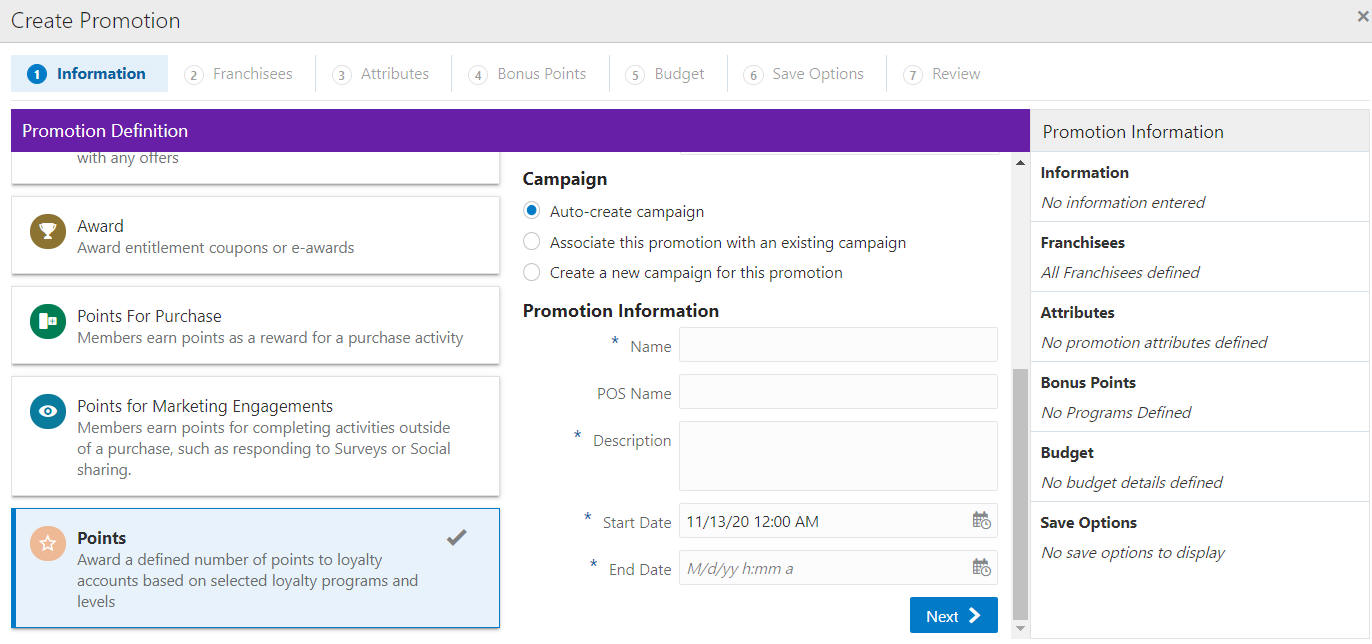
-
Select the Promotion Type: Points
Note:
Contact your administrator if you do not see the Promotion Types needed for your promotion
-
Select one of the choices for the Campaign.
-
Auto-create Campaign – The campaign is automatically created and will use the same name and description from the promotion name and description.
-
Associate this promotion with an existing campaign – Uses existing campaigns in the system.
-
Click the list arrow and select an existing campaign.
Note:
The Start Date and End Date display underneath the Existing Campaign list.
-
-
Create a new campaign for this promotion – A new campaign is created with this promotion being the first added.
-
-
Enter the following information:
-
Enter a Campaign Name (for new Campaigns only).
-
Enter a Description (for new Campaigns only).
-
Enter a Name.
-
Enter a POS Name.
-
Enter a Description.
-
Select a Start Date.
-
Select an End Date.
-
-
When finished entering the Campaign and Promotion information, click Next to continue to the Franchisees tab.
Note:
This tab will only display if the
EnableFranchiseSupportconfiguration is enabled, and Franchisees have been created. -
By default, all franchisees are assigned to the promotion. To make changes to those assignments, do the following:
Figure 5-142 Franchisees Tab

Assigning a Franchisee
-
Click the Actions Menu, then, click Assign, or click the Add (+) icon. This opens the Add Franchisee window.
Figure 5-143 Assign Franchisee
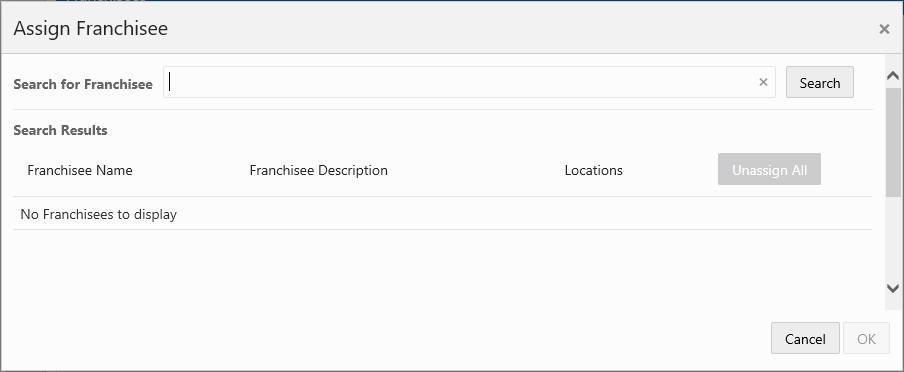
-
In the Search for franchisee search box, enter part or all of the Name, ID, or Description, then click Search.
Note:
You can also leave blank and click Search to return all Franchisees.
-
To change the assignment from ALL (which is defaulted) click Assign on just the specific franchisees you wish to assign for this promotion. Only Franchisees associated with the user are displayed in the list.
-
Click OK to accept the changes or Cancel to close the window without saving.
Figure 5-144 Confirmation Notification

Note:
A confirmation notification appears to confirm the franchisee has been assigned.
Deleting a Franchisee
-
In the included Franchisees window, highlight the desired row.
-
Click the Action Menu, and click Delete, or click the X icon.
Note:
A confirmation notification appears to confirm the franchisee has been deleted.
-
-
When finished entering the Franchisees information, click Next to continue to the Attributes tab.
-
Enter the following for the Attributes tab.
Figure 5-145 Select Attributes

Complete values for any Promotion Attributes you want added to the promotion. Fields marked with an asterisk are required.
-
When finished adding Attributes for the Promotion, click Next to continue to the Bonus Points tab.
-
Take the following actions for the Bonus Points tab.
Figure 5-146 Bonus Points Tab

-
Select one of the following options:
-
Active Accounts at Promo Start Date -The bonus points will be applied to all active accounts for the selected Loyalty Programs and Levels. This will apply to all accounts regardless if there is a customer registered to the account.
-
Active Accounts Updated Dynamically - The bonus points will be applied to all active accounts for the selected Loyalty Programs and Levels. Additionally, any accounts added during the promotion period will also receive the bonus points. This will apply to all accounts regardless if there is a customer registered to the account.
-
Active Accounts With Registered Customers - The bonus points will be applied to all active accounts for the selected Loyalty Programs and Levels. This will apply to only accounts that have a customer registered to the account. Additionally, this will enable the Audience tab to display and provide the ability to further define the loyalty members that receive the promotion by selecting appropriate segments.
-
-
Click + Add Programs.
Result: The Add Programs window appears.
Figure 5-147 Add Programs
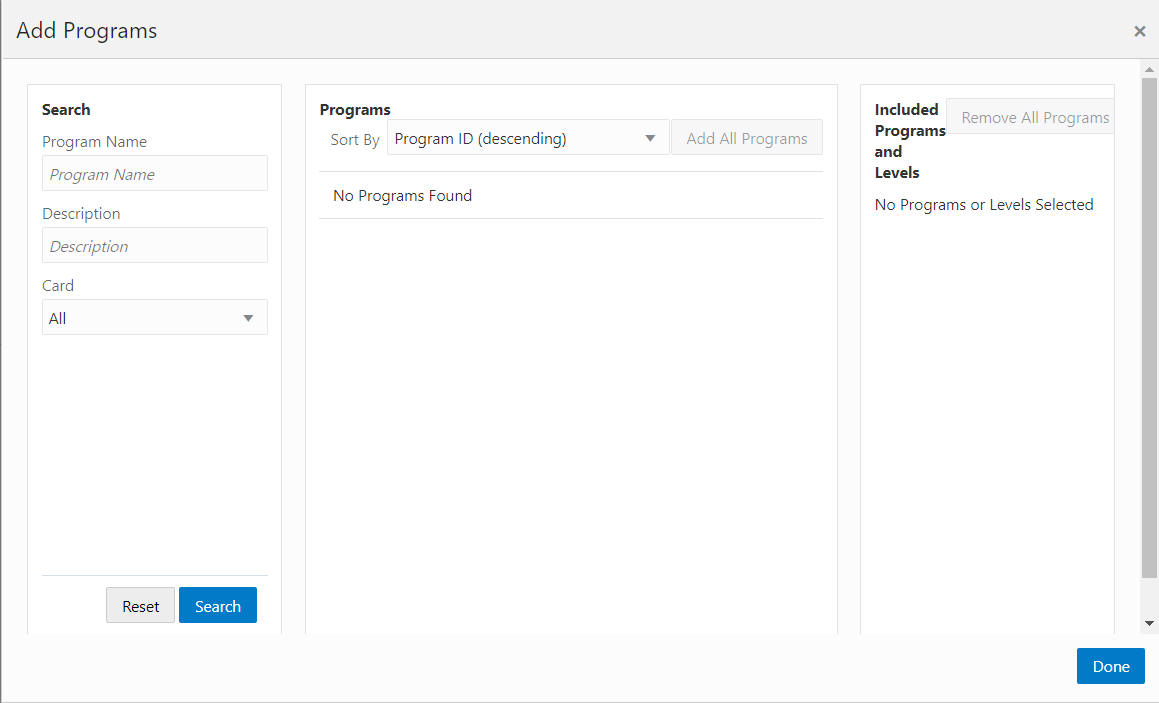
-
In the Search for programs search box, enter part or all of the Program Name, or Description.
-
Click the Card options list
-
Select a Card.
A list of cards display all active cards for the user to select from. If there is only one card to select from, the card appears by default and the list arrow is unavailable for selection. The default card selection is All.
-
-
Click Search to view the results, or click Reset to clear the selections. All programs appear if no criteria is entered.
Figure 5-148 Add Programs Search Results
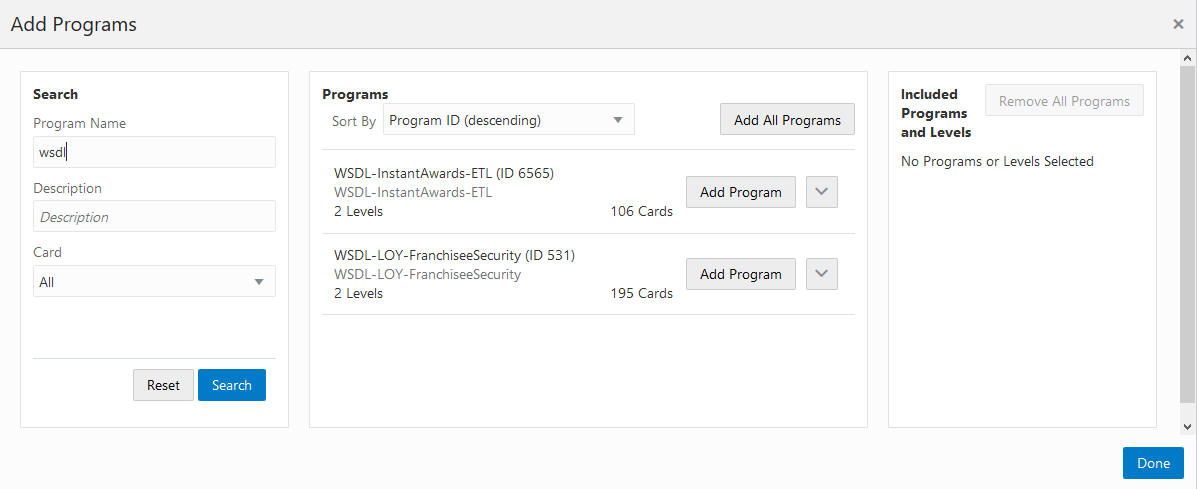
-
Sorting options include:
-
Program ID (ascending)
-
Program ID (descending) - Default
-
Program Name (ascending)
-
Program Name (descending)
-
-
-
To add a program perform one of the following options:
Figure 5-149 Programs Search Results Options

-
Click Add All Programs to include all programs listed in the search results.
-
Click Add Program to include the program and all levels in that program.
-
Click either the up or down arrows located next to Add Program to hide/display the available levels for each program. Click Add to only add a specific loyalty level for each program.
-
-
To remove included programs and levels click the X icon for each entry. You can also click Remove All Programs.
-
Click Done.
Result: The included programs appear and are ready for points value assignments.
Figure 5-150 Included Programs - Assign Points

Note:
The last column header for the Included Programs are based on which Issue Points To option is selected. Active Accounts with Registered Customers are Members. All other options are Cards.
-
There are two options for adding points to the Included Programs:
-
To increase or decrease the number of points for all programs, either:
-
Enter the number of points in the Points field located next to the + Add Program button.
-
Use the up or down arrows to reach the desired number.
-
-
To increase or decrease the number of points for individual programs, either:
-
Enter the number of points in the Points field located in the table for each entry.
-
Use the up or down arrows to reach the desired number.
-
-
-
When finished configuring the Bonus Points for the Promotion, click Next.
-
If the Bonus Points issues points to Active Accounts at Promo Start Date, go to Step 31 to continue to the Budget tab.
-
If the Bonus Points issues points to Active Accounts Updated Dynamically, go to Step 31 to continue to the Budget tab.
-
If the Bonus Points issues points to Active Accounts with Registered Customers, continue to the next step, the Audience tab.
-
-
Take the following actions for the Audience tab.
Figure 5-151 Audience Tab
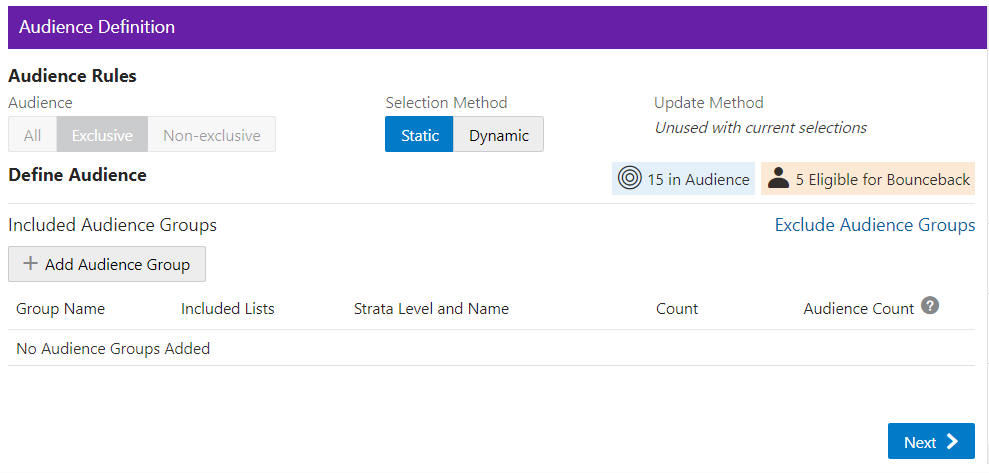
Audience Rules – Exclusive is the only option available for the Points Promotion to define the audience.
Exclusive Targeting - If you create an exclusive targeted promotion, this means that only the customers you've identified in your target group are eligible to receive the promotion at the point of sale.
-
The Selection methods include:
-
Static – Only customers defined at this time are considered eligible for the promotion.
-
Dynamic – Dynamic can not only add customers but also remove customers that no longer apply. When Dynamic is selected, Update Method is available.
New audience members will be added – When the Dynamic Promotions job runs, any new customers found that meet the criteria, are added to the audience. All customers currently in the audience will remain in the audience.
Audience members can be added and removed – When the Dynamic Promotions job runs, any new customers found that meet the criteria, are added to the audience. Additionally, only the customers that meet the criteria will be included in the audience. If the customer is in the audience before the job runs, but no longer meets the criteria, the customer will be removed from the audience.
-
Define Audience - Included Audience Groups
-
Click + Add Audience Group.
Figure 5-152 Add Audience Group (Include)

-
Select an Available List type
All - Default
Stratified - The Customers within a Stratified list are divided into levels.
Unstratified - Customers maintained by the user.
Personal - Customers maintained by the user.
-
In the Search field, enter some or all of the List Name, ID, or Strata Name.
-
Click Search. The results can be sorted by using the Sort by list menu with the following options:
Last Updated
Name
Customer Count
-
Enter a Group Name.
When lists are added from the Available Lists area, they appear in the Audience Groups section of the window. The Audience Group section Group Name automatically defaults to the name of the first list added. You can change the Group Name to something more meaningful to describe the group of customers, if desired.
Figure 5-153 Add Audience Group (Include)

-
Click Add to add the selection Assigned Audience Lists.
-
Click Add for another list means you are using the condition AND. Both conditions must be met.
-
Click OK and Add Another to keep you in the same window and use the condition OR. One or more of the conditions must be met when you click Add for another Audience Group.
Figure 5-154 Audience Definition
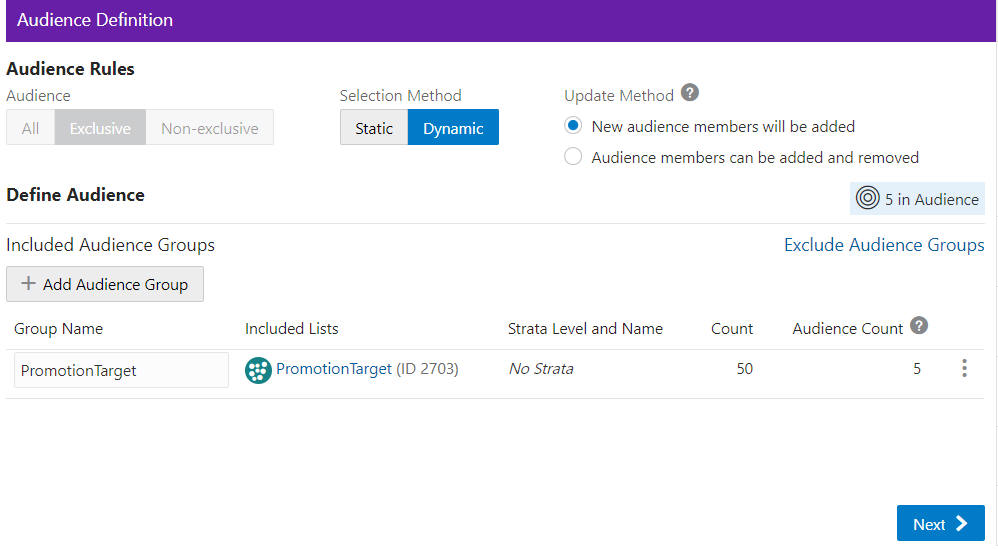
As shown in Figure 5-154 the Count is shown for each audience group. In the Audience Rules section the Audience Count is provided on the right hand side.
Columns include the following details:
-
Group Name
-
Included Lists
-
Strata Name and Level (if applicable)
-
Count
-
Audience Count
Each Group Name has an Overflow Menu Icon where you can Edit or Remove the Audience Group from the list.
The Included Lists column displays a link on that list (also known as a segment) and that link will open to the Audience List Details window.
In this window, the following sections may display, depending on the type of list and which of the options were selected when the list was created:
-
List Options section
-
Criteria section
-
Trend Results section
-
Strata Levels section
-
Attributes section
-
Franchisees section
-
Message section
-
Scheduled Jobs section
Figure 5-155 List Details
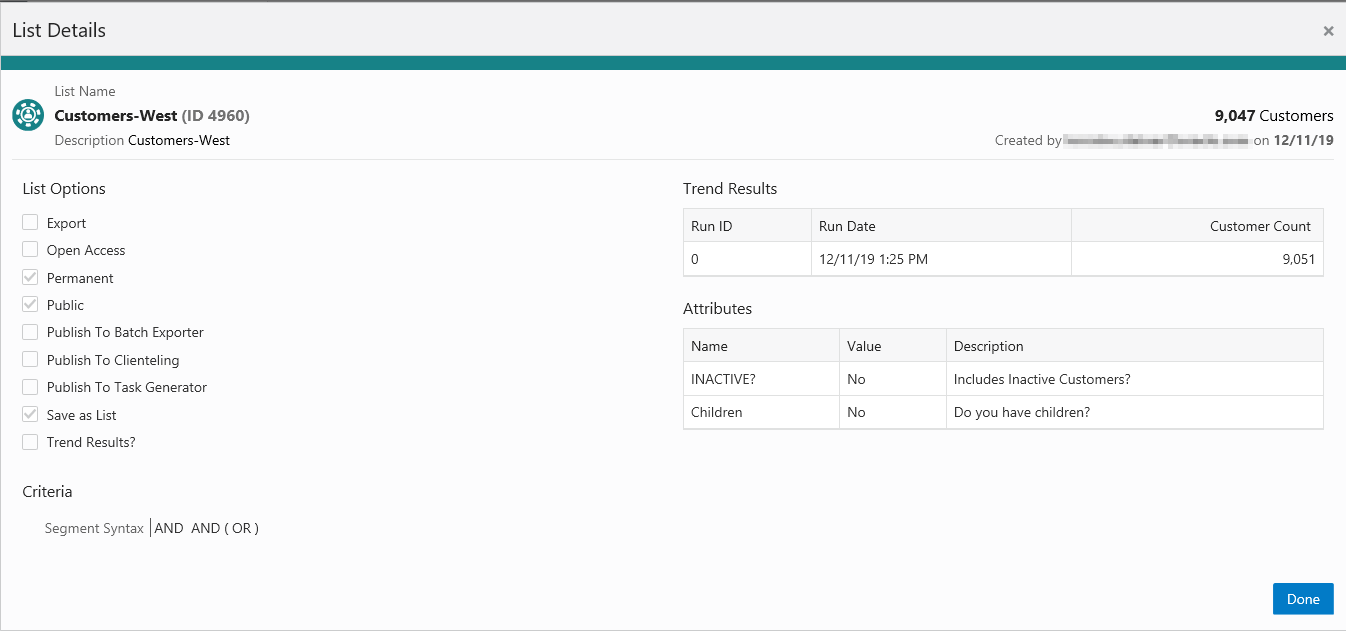
The checked List Options vary by the selections made when the list was created, and may include the following fields:
-
Export – Indicates whether the Segment list is automatically exported after the Segment Query is run.
-
Open Access – Indicates whether the Segment has Open Access.
-
Permanent – Indicates whether the Segment is kept in the system, even if it meets the criteria for deletion by the housekeeping job.
-
Public – Indicates whether the Segment is Public.
-
Publish to Batch Exporter – Indicates whether the Segment has been made available for export to a Marketing system.
-
Publish to Clienteling – Indicates whether the Segment has been made available to the Clienteling module.
-
Publish to Task Generator – Indicates whether the Segment has been made available to the Task Generator Job.
-
Save as List – Indicates whether a list of matching Customer IDs is created when the Segment is created.
-
Trend Results – Indicates whether the results of the Segment run are kept to provide trend information about the Segment.
Figure 5-156 displays the Trend Results in a chart. A user can scroll down to see a table as shown in Figure 5-157, which for this segment shows the Strata Levels Against Customer Age and displays the strata that are shown in the graph.
Figure 5-156 List Details Trend Results - Chart
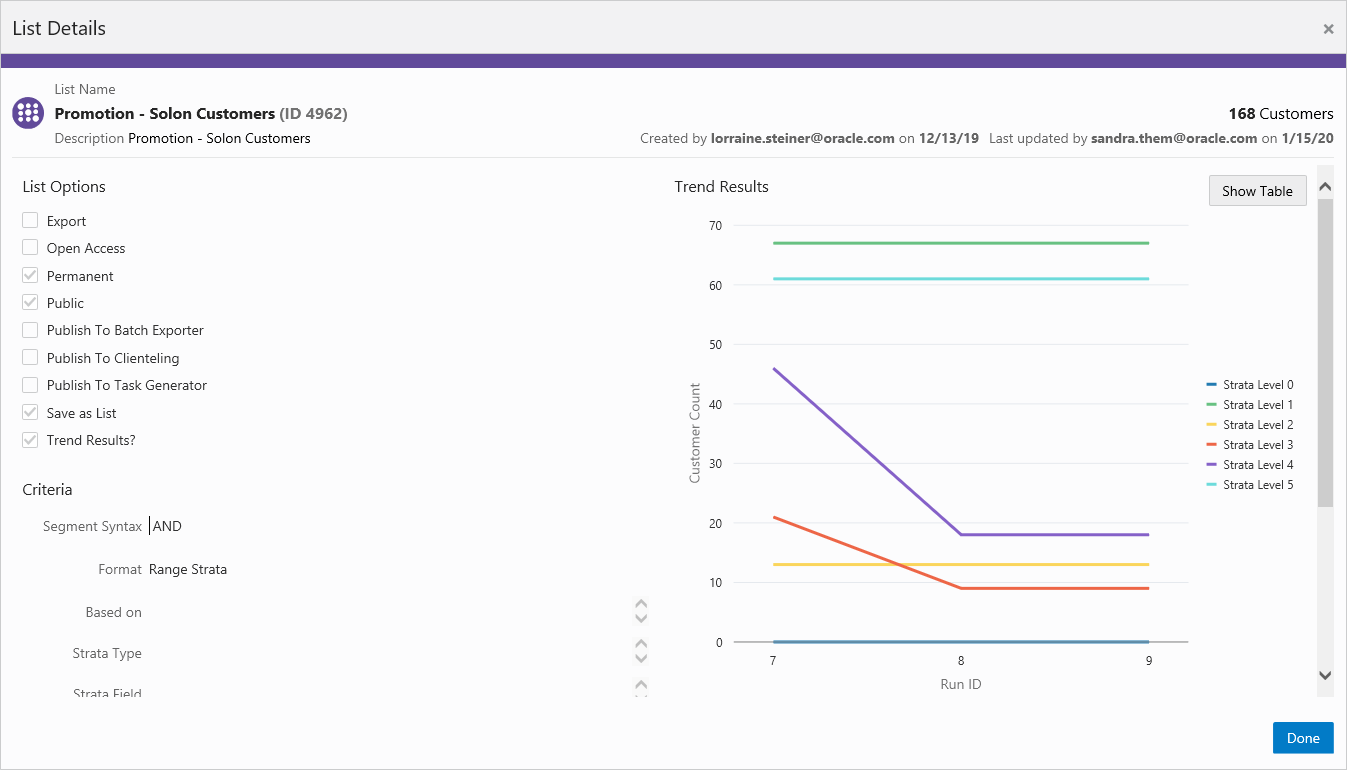
Figure 5-157 Trend Results Graph - Table

Figure 5-158 List Details Trend Results - Table
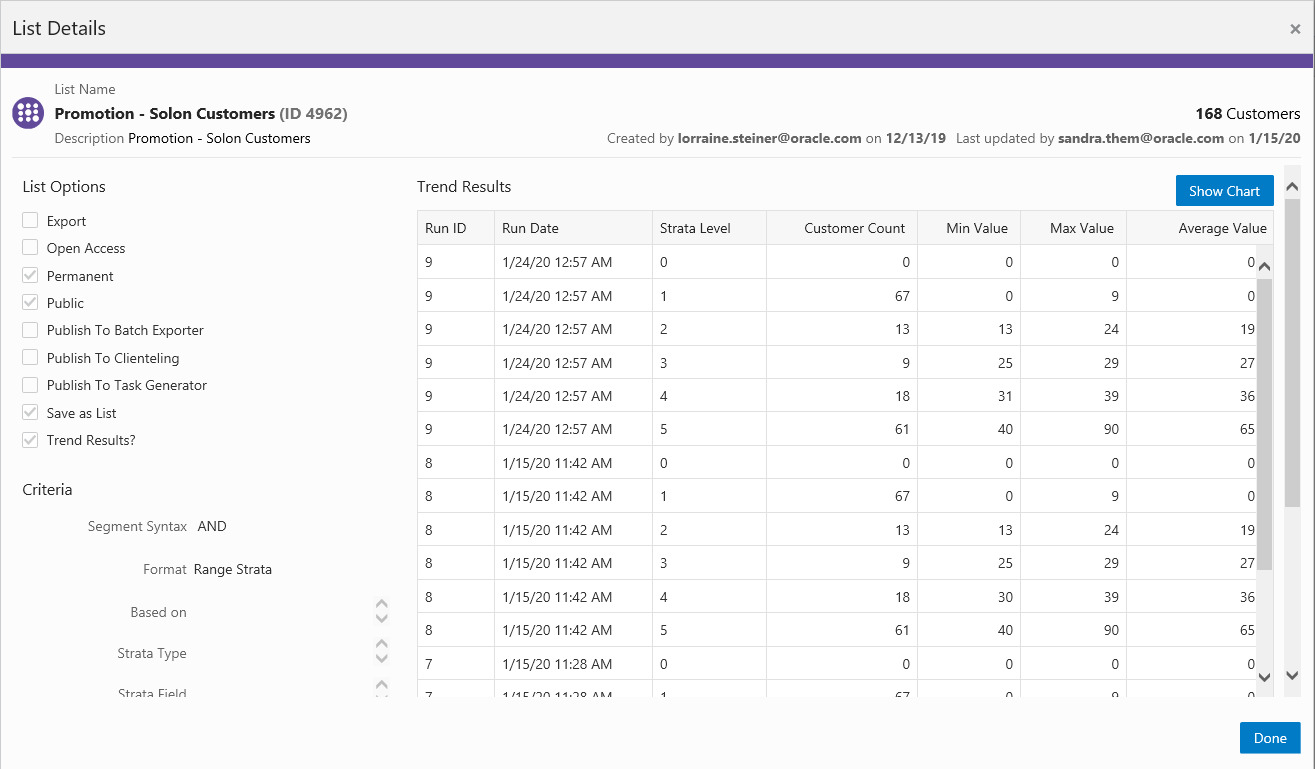
-
Click Done to close the Audience List Details window.
Figure 5-159 Audience Definition - Exclude Audience Groups
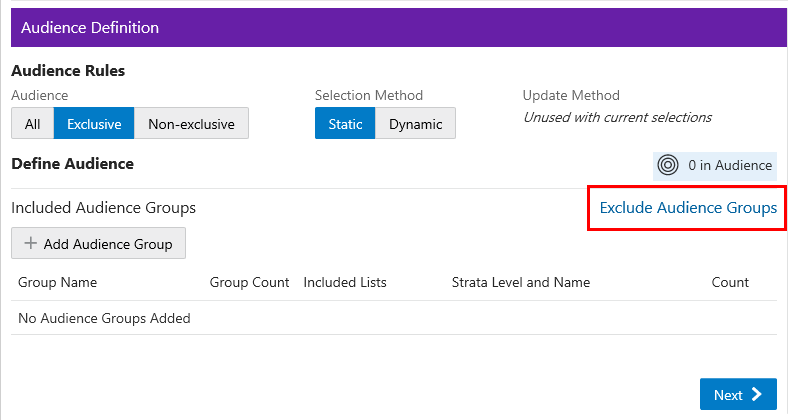
Exclude Audience Groups - If you wish to exclude certain groups of customers that may also be a part of the Included Group, you can do that by selecting the Exclude Audience Groups link, which opens a new section in the Audience Definition window
-
Select the Exclude Audience Groups link.
-
Click + Add Audience Group.
-
Select an Available List type.
-
-
All – Default group listing.
-
Stratified – The Customers within a Stratified list are divided into levels.
-
Unstratified – The Customers within an Unstratified list are not differentiated into separate groups.
-
Personal – User created groups.
-
-
In the Search field, enter some or all of the List Name, ID, or Strata Name.
-
Click Search.
-
The results can be sorted by using the Sort by list menu with the following options:
-
Last Updated
-
Name
-
Customer Count
-
-
Enter a Group Name.
-
Click Add to add the selection Assigned Audience Lists.
-
Click Add for another list means you are using the condition AND. Both conditions must be met.
-
Click OK and Add Another to keep you in the same window and use the condition OR. One or more of the conditions must be met when you click Add for another Audience Group.
-
-
When finished entering all Audience Groups for the Promotion, click Next.
-
Enter the following for the Filtering Audience tab.
Figure 5-160 Filtering Audience Tab
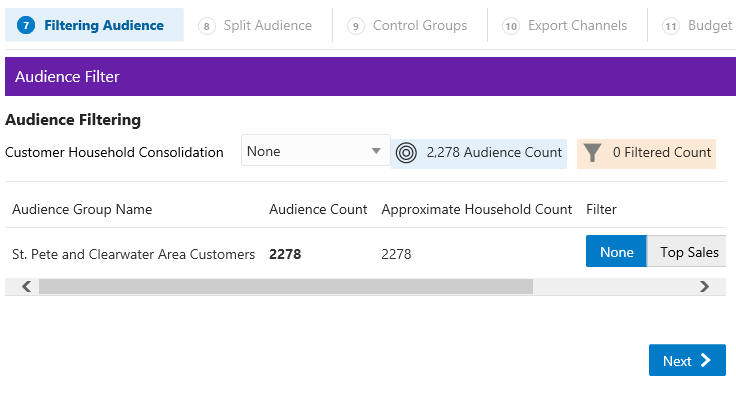
Use the Customer Household Consolidation Selection Menu to indicate whether the Promotion will use household consolidation, and the rule for determining the Customer who is the head of household.
-
None – Do not perform household filtering.
-
LT Sales – Select head of household based on amount purchased over the lifetime of their account.
-
LT Transaction Count – Select head of household based on lifetime number of transactions.
-
Last Transaction Date – Select head of household based on the Customer who performed the most recent transaction.
-
Customer Attributes – Select head of household based on the Customer's numeric attributes.
Select the Filter Type for each Audience:
Figure 5-161 Select Desired Filtering
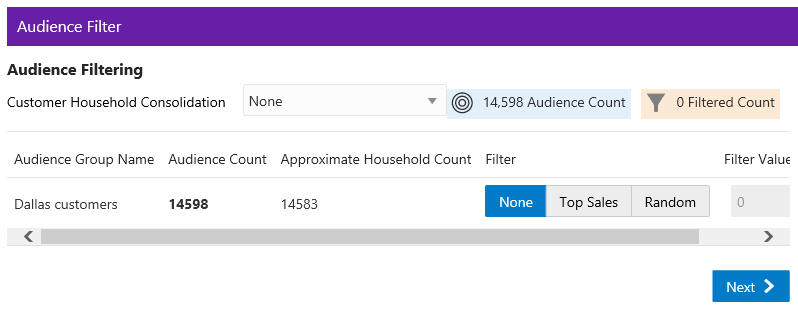
-
None - [DEFAULT] All Customers in the Audience Group are eligible.
-
Top Sales - Customers from the Audience Group will be chosen for eligibility by the greatest total amount of purchases.
-
Random - Customers from the Audience Group will be chosen randomly for eligibility.
Enter a filter value to indicate the number of customers eligible for the promotion.
-
-
When finished entering any household filtering for the Audience Groups for the Promotion, click Next to continue to the Split Audience tab.
-
In the Split Audience tab, filtered audiences can, optionally, be split into smaller, separate audiences. If desired, create splits for the filtered audiences on the promotion.
-
Click Split.
Figure 5-162 Split Audience Groups
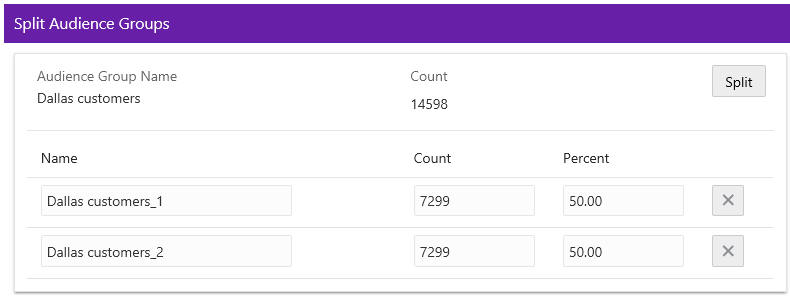
-
The Split Name field is automatically populated from the name of the Audience Group Name. If desired, you can change the name of the splits in this step.
-
Select Split to automatically divide the Audience Group into equal portions and percentages. If you desire different portions or percentages for the splits, enter either a count or a percentage, and the corresponding field will update.
-
-
When finished entering any Audience Group splits for the Promotion, click Next to continue to the Control Groups tab.
-
Enter the following information for the Control Groups tab.
Figure 5-163 Define Control Groups
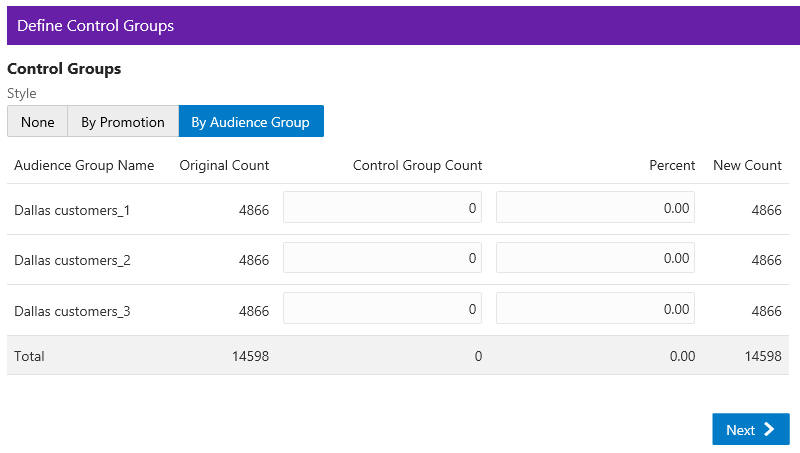
The control group is a statistically identical group that doesn't receive the offer. Following the promotional period, the results of the two groups are compared and you can determine if the offer generated incremental revenue. Options include:
-
None – No Control Group
-
By Promotion – Enter either a New Count or Percent. The corresponding field will update automatically to determine the size of the control group.
-
By Audience Group – Enter either a Control Group count or percentage for each split created earlier. The corresponding field will update automatically.
-
-
When finished entering any Control Groups for the Promotion, click Next to continue to the Export Channels tab.
-
Enter the following information for the Export Channels tab. The options include:
Figure 5-164 Export Channels Tab
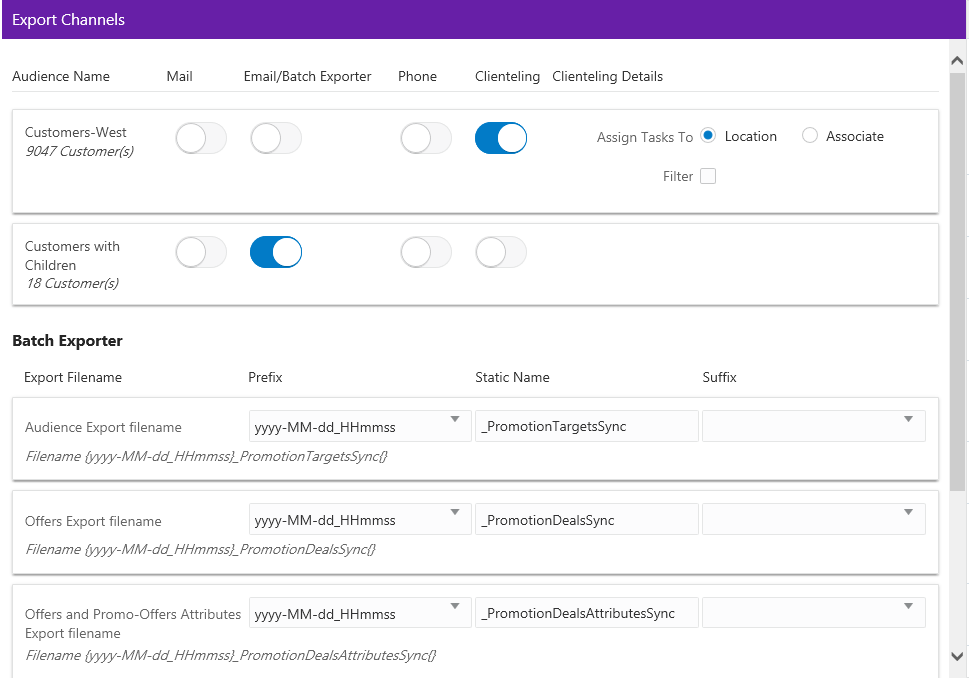
Mail - Determines whether the Customers in the Split/Control Group will be contacted by Mail.
EMail / Batch Exporter - Determines whether the Customers in the Split/Control Group will be contacted by Email.
Note:
The system configuration setting SupportedBatchExporters determines if the Batch Exporter section is displayed.
-
Export Filename – Name of the file.
-
Prefix – Indicates the format of the datetime stamp used as a prefix the filename. Optional. Possible settings are yyyyMMdd_HHmmss, yyyy-MMdd_HHmmss, or none.
-
Static Name – The identifying filename.
-
Suffix – Indicates the format of the datetime stamp used as a suffix the filename. Optional. Possible settings are yyyyMMdd_HHmmss, yyyy-MMdd_HHmmss, or none.
-
Filename – Displays an example of the export file name with the prefix and suffix format, if any.
Phone - Determines whether the Customers are contacted by phone.
Clienteling – When the Clienteling switch is turned on, tasks will be created based on the assigned associates or locations for the defined target audience when the promotion is generated.
Figure 5-165 Clienteling Details

Assign Tasks to:
-
Location Channel – Tasks are assigned to a Location.
-
Associate Channel – Tasks are assigned to an associate in a location.
The following fields are enabled if the Filter option is selected:
-
Max Count Per <type> - Determines the maximum number of target Customers that will be contacted through the channel.
-
Method - Method used to select the Customers contacted. Options include:
-
Random - Select Customers Randomly (Default).
-
Top - Recent Purchase - Filter the Customers based on the most recent purchases.
-
Top - LT Sales - Filter the Customers based on the largest amount purchased over the lifetime of their account.
-
Top - Numeric Attribute - Filter the Customers based on the highest attribute value for a selected numeric attribute. If this option is selected, an additional Channel Filter option, Attribute, displays. Attribute is the numeric attribute used to determine the customers contacted
-
-
-
When finished entering any Export Channels for the Promotion, click Next to continue to the Budget tab.
-
Enter the following information on the Budget tab.
Figure 5-166 Budget Tab
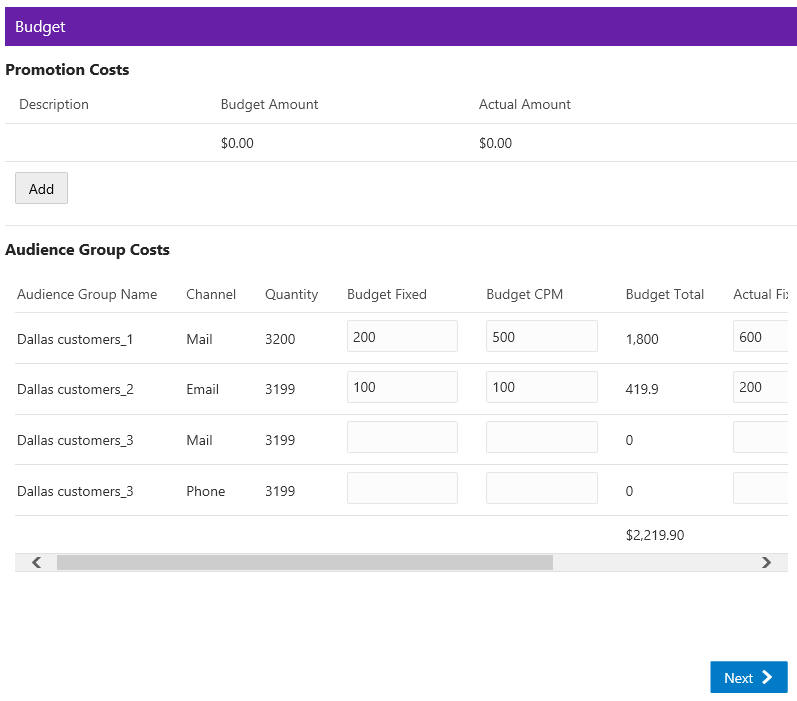
-
Click Add to enter the Promotion Costs. Enter values in any field is optional.
-
Enter a Description of the cost item.
-
Enter the budgeted amount for the Promotion in the Budget Amount field.
-
Enter the actual amount for the Promotion in the Actual Amount field.
-
Click Add if you wish to enter another budget line for the promotion, then follow steps a-d to complete the fields.
If Export Channels were selected for the audience group, the Audience Groups Costs section appears. Entering values in any field is optional.
Figure 5-167 Audience Group Costs
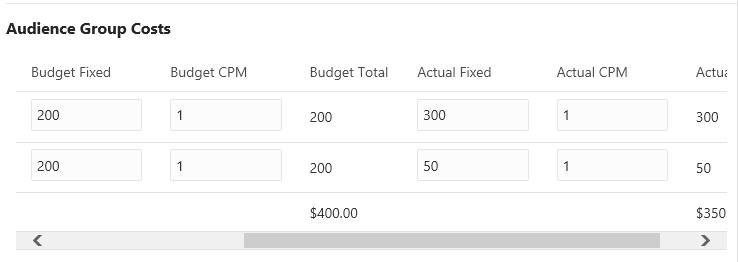
-
In the Budget-Fixed field, enter the fixed cost budgeted for the audience.
-
In the Budget-CPM field, enter the cost budgeted for the Channel for each 1,000 Customers.
-
In the Actual-Fixed field, enter the actual fixed cost of the Channel.
-
In the Actual-CPM field, enter the actual cost of the Channel for each 1,000 Customers.
-
Repeat steps f-i for each Target Channel in the Promotion.
-
-
When finished entering any Budget Costs for the Promotion, click Next to continue to the Save Options tab.
-
Enter the following information in the Save Options tab. You can enter more than one choice.
Figure 5-168 Options After Save Tab
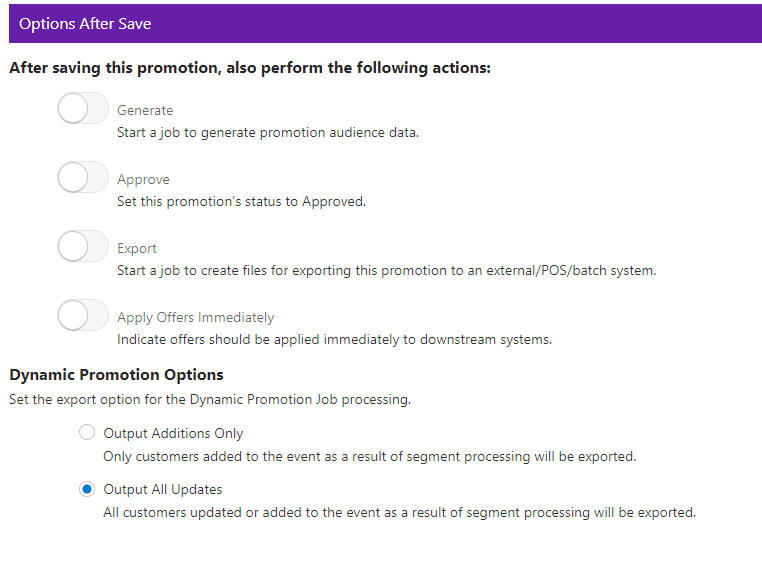
-
Generate – Start a job to generate promotion audience data.
-
Approve – Set this promotion's status to Approved.
-
Export – Start a job to create files for exporting this promotion to an external/POS/batch system. This option automatically approves the Promotion.
-
Dynamic Promotion Options – Select one of the two export options for processing when using the Dynamic selection method on the Audience tab.
Note:
Depending on the type of promotion that you created, different Options After Save are available.
-
-
When finished entering any Save Options for the Promotion, click Next to continue to the Coupon Review tab.
-
The Review tab displays the key elements in the Promotion Setup.
Figure 5-169 Review Tab
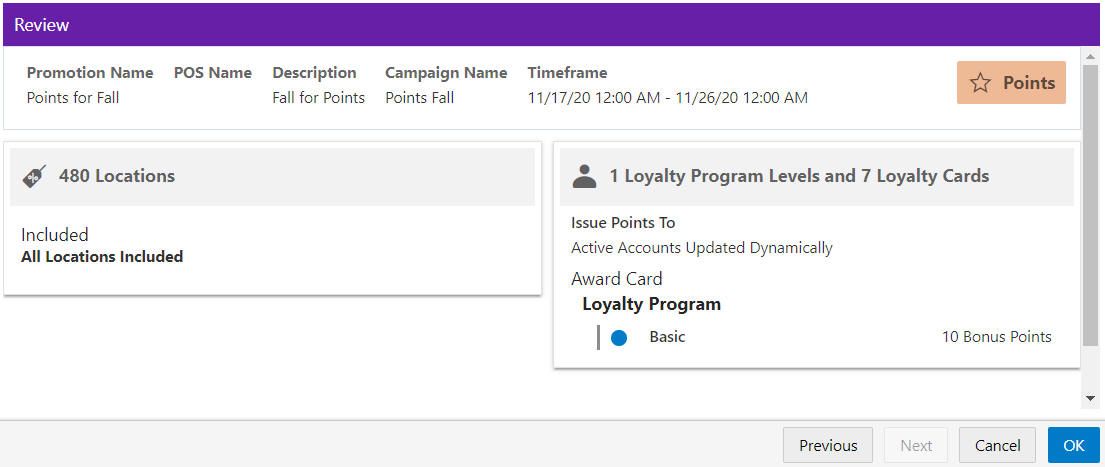
-
Click OK to save the Promotion, or click Cancel to close the promotion without saving. Click Previous or any Tab to return to any point of the Create Promotion process.